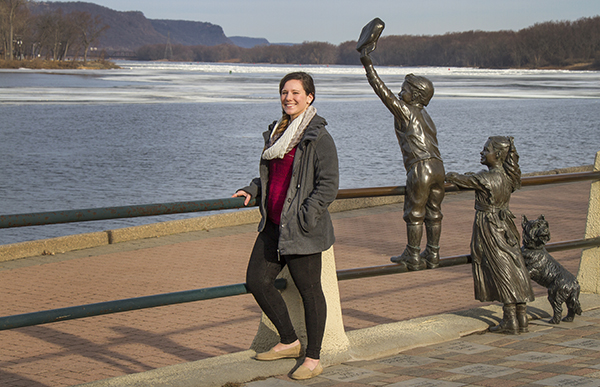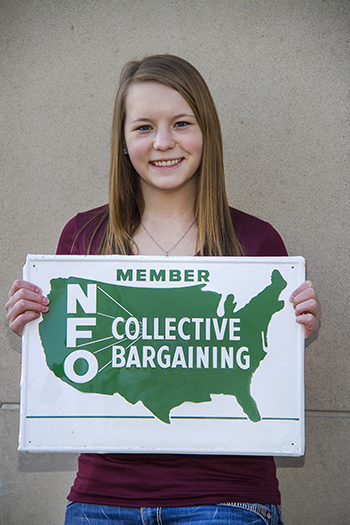[caption id="attachment_39809" align="alignleft" width="600"]

Catherine Krus, a senior from Chicago, says the Mississippi River has intrigued her since she moved to area to attend UW-La Crosse. She selected the Riverside Park sculpture “A Simpler Time” as her object for a history class project based on a new statewide website.[/caption]
The big sunfish in Onalaska. The “Simpler Time” sculpture of children and their dog greeting boats at Riverside Park. A metal 1960s Wisconsin National Farmers Organization (NFO) sign. What do they have in common? They’re objects UW-La Crosse students have selected for a statewide public history project.
The idea of “
Wisconsin 101: Our History in Objects” is simple. Students, amateur historians and others interested in the state’s history can select a material object and provide researched information about its importance in state history. For the UW-L classes, objects were selected from the university’s Area Research Center, La Crosse Historical Society and students’ homes.
UW-L History Assistant Professor Patricia Stovey says the new project — recently launched online at
www.wi101.org — was perfect for her survey course on Wisconsin History.
“This project allows students to expand their work out of the classroom,” she explains. “Students can take the objects in the direction they want to go.”
The student who selected the NFO sign plans to recall the state’s stormy agricultural issues. Onalaska’s sunfish sculpture will relay history of Lake Onalaska, the Mississippi River, its wing dams and more. The Riverside Park sculpture is sparking tales of river history.
That NFO sign
[caption id="attachment_39812" align="alignright" width="350"]

Miranda Kunes, a senior from Melrose, Wisconsin, selected an NFO member sign for the “Wisconsin 101: Our History in Objects” project. Kunes was surprised to discover that many NFO demonstrations in the ’60s and ’70s were violent, often resulting in harm to people, animals or property.[/caption]
Miranda Kunes, a senior from Melrose, says she selected the NFO member sign after talking with her dad about Wisconsin’s agricultural industry climate in the ’60s and ’70s.
Kunes was surprised to find that many NFO demonstrations included guns, explosives, threats, roadblocks and vandalism that often resulted in harm to people, animals or property.
“When I think of Wisconsin farmers, I do not imagine them as violent or politically radical individuals,” says Kunes, a communication studies major. “However, my research has proved this assumption wrong.”
The ‘Simpler Time’ sculpture
Catherine Krus, a senior from Chicago, says the river has intrigued her since she moved to La Crosse for college. “I often find myself leaning on the railing like the kids in the sculpture, looking out at the bluffs as they fade into the horizon,” she notes.
Growing up in Chicago, Krus knows all about the World's Fair, the Great Chicago Fire and history behind much of the city. Learning Wisconsin history was new to her.
“I am so excited to learn about a place that is greatly different from where I grew up,” she says. “It gives me a great appreciation for this land and the people in it.”
Krus also learned more about the artist of the sculpture, Michael Martino, a snow sculptor who brought home the bronze medal from the Winter Olympics Arts Festival in Liyama, Japan, in 1998.
She hopes to meet Martino. “I'm sure he could give me some insight into ‘A Simpler Time’ and what the reason behind the design was,” she says.
Site’s history is growing
The website was launched earlier this year and has only a few objects identified, mainly in the Milwaukee area. “Hopefully, we can offer a La Crosse spin on state history,” says Stovey.
Stovey’s assignment is just a small portion of one of her spring semester classes, one that includes 30 juniors and seniors from a variety of majors. Students wanting to see their work make the website will have to do more extensive research on their objects than just the class assignment. They will also be encouraged to turn their initial findings into a hands-on undergraduate research project. Both Kunes and Krus plan to wait to see how their research turns out before deciding if they will submit it to the site.
Stovey was one of the state’s historians who got in on the online public history project at the ground level. The brainchild of UW-Madison Professors Tom Broman and Sarah Thal, the project started a year ago as an outlet for student work. They hope the project helps connect state residents while increasing interest and awareness of research, writing and curation of history throughout the state.
“Wisconsin 101: Our History in Objects” — a statewide, collaborative, public history online exhibit that explores the multidimensional histories of material objects in Wisconsin, highlighting the interconnected pasts of individuals and communities. By hosting histories researched and written by students, amateur historians, and others about objects of significance to their communities, the site seeks to:
• create among Wisconsin residents a sense of the interconnectedness of histories that cuts across regional, cultural, economic, political and institutional differences.
• increase interest and engagement in humanities-based research in Wisconsin.
• increase student and community expertise, and public awareness of the relevance of expertise, in research, writing, curation and publishing.
• foster statewide interest in and engagement with local and Wisconsin history and objects, as well as the institutions that house and study them.
See it at:
www.wi101.org
 Catherine Krus, a senior from Chicago, says the Mississippi River has intrigued her since she moved to area to attend UW-La Crosse. She selected the Riverside Park sculpture “A Simpler Time” as her object for a history class project based on a new statewide website.[/caption]
The big sunfish in Onalaska. The “Simpler Time” sculpture of children and their dog greeting boats at Riverside Park. A metal 1960s Wisconsin National Farmers Organization (NFO) sign. What do they have in common? They’re objects UW-La Crosse students have selected for a statewide public history project.
The idea of “Wisconsin 101: Our History in Objects” is simple. Students, amateur historians and others interested in the state’s history can select a material object and provide researched information about its importance in state history. For the UW-L classes, objects were selected from the university’s Area Research Center, La Crosse Historical Society and students’ homes.
UW-L History Assistant Professor Patricia Stovey says the new project — recently launched online at www.wi101.org — was perfect for her survey course on Wisconsin History.
“This project allows students to expand their work out of the classroom,” she explains. “Students can take the objects in the direction they want to go.”
The student who selected the NFO sign plans to recall the state’s stormy agricultural issues. Onalaska’s sunfish sculpture will relay history of Lake Onalaska, the Mississippi River, its wing dams and more. The Riverside Park sculpture is sparking tales of river history.
Catherine Krus, a senior from Chicago, says the Mississippi River has intrigued her since she moved to area to attend UW-La Crosse. She selected the Riverside Park sculpture “A Simpler Time” as her object for a history class project based on a new statewide website.[/caption]
The big sunfish in Onalaska. The “Simpler Time” sculpture of children and their dog greeting boats at Riverside Park. A metal 1960s Wisconsin National Farmers Organization (NFO) sign. What do they have in common? They’re objects UW-La Crosse students have selected for a statewide public history project.
The idea of “Wisconsin 101: Our History in Objects” is simple. Students, amateur historians and others interested in the state’s history can select a material object and provide researched information about its importance in state history. For the UW-L classes, objects were selected from the university’s Area Research Center, La Crosse Historical Society and students’ homes.
UW-L History Assistant Professor Patricia Stovey says the new project — recently launched online at www.wi101.org — was perfect for her survey course on Wisconsin History.
“This project allows students to expand their work out of the classroom,” she explains. “Students can take the objects in the direction they want to go.”
The student who selected the NFO sign plans to recall the state’s stormy agricultural issues. Onalaska’s sunfish sculpture will relay history of Lake Onalaska, the Mississippi River, its wing dams and more. The Riverside Park sculpture is sparking tales of river history.
 Miranda Kunes, a senior from Melrose, Wisconsin, selected an NFO member sign for the “Wisconsin 101: Our History in Objects” project. Kunes was surprised to discover that many NFO demonstrations in the ’60s and ’70s were violent, often resulting in harm to people, animals or property.[/caption]
Miranda Kunes, a senior from Melrose, says she selected the NFO member sign after talking with her dad about Wisconsin’s agricultural industry climate in the ’60s and ’70s.
Kunes was surprised to find that many NFO demonstrations included guns, explosives, threats, roadblocks and vandalism that often resulted in harm to people, animals or property.
“When I think of Wisconsin farmers, I do not imagine them as violent or politically radical individuals,” says Kunes, a communication studies major. “However, my research has proved this assumption wrong.”
Miranda Kunes, a senior from Melrose, Wisconsin, selected an NFO member sign for the “Wisconsin 101: Our History in Objects” project. Kunes was surprised to discover that many NFO demonstrations in the ’60s and ’70s were violent, often resulting in harm to people, animals or property.[/caption]
Miranda Kunes, a senior from Melrose, says she selected the NFO member sign after talking with her dad about Wisconsin’s agricultural industry climate in the ’60s and ’70s.
Kunes was surprised to find that many NFO demonstrations included guns, explosives, threats, roadblocks and vandalism that often resulted in harm to people, animals or property.
“When I think of Wisconsin farmers, I do not imagine them as violent or politically radical individuals,” says Kunes, a communication studies major. “However, my research has proved this assumption wrong.”
